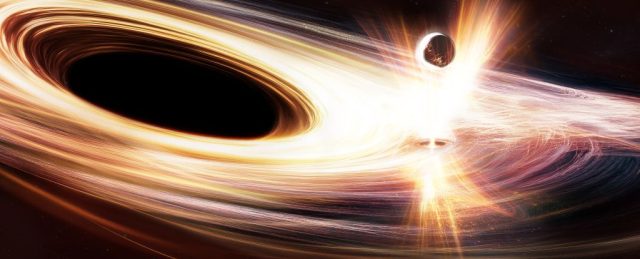A supermassive black hole 300 million light-years away has astrophysicists stumped.
It lurks at the center of a galaxy called SDSS1335+0728, and, since 2019, researchers have been watching in real-time as it awoke from a quiescent slumber and started blazing with activity, belching out a series of eruptions of light.
This in itself is consistent with how we know supermassive black holes to behave. But the behavior of this particular black hole – nicknamed Ansky – is so weird and wild that it’s challenging to explain.
“The bursts of X-rays from Ansky are 10 times longer and 10 times more luminous than what we see from a typical quasi-periodic eruption,” says astrophysicist Joheen Chakraborty of MIT.
“Each of these eruptions is releasing a hundred times more energy than we have seen elsewhere. Ansky’s eruptions also show the longest cadence ever observed, of about 4.5 days. This pushes our models to their limits and challenges our existing ideas about how these X-ray flashes are being generated.”
The popular perception of a black hole is that of a cosmic vacuum cleaner, sitting in space constantly slurping up everything around it. This is only part of the rich and complex existence of the densest known objects in the Universe.
Like anything with mass, their gravitational reach only extends so far; supermassive black holes can go through periods of raging activity, and periods of relative quiet, during which they just sort of sit there not really accreting much material at all. The supermassive black hole at the center of the Milky Way, for instance, is relatively quiescent.
Astronomers believe that supermassive black hole activity, in which they devour huge amounts of material from the space around them, is critical to the evolution of the black holes and the galaxies that surround them.
For one, the black holes have to have grown to their tremendous sizes somehow; and active supermassive black holes throughout the Universe suggest that active accretion is part of the growth process. In addition, most galaxies have a supermassive black hole in their centers. The activity of that black hole plays a role in its galaxy’s star formation and chemical evolution.
We know that supermassive black holes can be active or quiescent, and that they can transition between the two states, sputtering to life in a series of quasi-periodic eruptions. In 2019, Ansky became the first supermassive black hole observed switching to an active state in real-time.
“This is the first time we have observed such an event in a black hole that seems to be waking up,” says astronomer Lorena Hernández-García of the Millennium Institute of Astrophysics (MAS) and the University of Valparaíso in Chile, who led the research.
“The first quasi-periodic eruption episode was discovered in 2019, and since then we’ve only detected a handful more. We don’t yet understand what causes them. Studying Ansky will help us to better understand black holes and how they evolve.”
A black hole itself emits no detectable light. Activity in the extreme gravitational environment around a black hole is another matter. The friction and gravity at play in the material swirling around a supermassive black hole produce extreme temperatures that blaze with light as a black hole feeds.
Scientists had thought that quasi-periodic eruptions kick off when an object such as a star or small black hole wanders a bit too close to a supermassive black hole and gets tangled up in the material swirling around it, causing repeated flares.
The light detected emanating from Ansky, however, is not easy to explain. It’s extremely bright across a range of wavelengths, from infrared to X-rays, and the eruptions last longer than predicted for a cosmic interloper. This is tremendously exciting… but it does mean that we’re going to need a lot more data.
“We thought that quasi-periodic eruptions were the result of small celestial objects being captured by much larger ones and spiraling down towards them. Ansky’s eruptions seem to be telling us a different story. These repetitive bursts are also likely associated with gravitational waves that ESA’s future mission LISA might be able to catch,” says astronomer Erwan Quintin of the European Space Agency.
“It’s crucial to have these X-ray observations that will complement the gravitational wave data and help us solve the puzzling behavior of massive black holes.”
The research has been published in Nature Astronomy.










